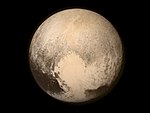astro.wikisort.org - Meteorite
K2-3b also known as EPIC 201367065 b is an exoplanet orbiting the red dwarf K2-3 every 10 days.[2][4] It is the largest and most massive planet of the K2-3 system, with about 2.3 times the radius of Earth and almost 7 times the mass. Its density of about 3.0 g/cm3 indicates a composition of almost entirely water, or a hydrogen envelope comprising 0.7% of the planet's mass.[3]
| Discovery[1] | |
|---|---|
| Discovery site | Kepler Space Observatory |
| Discovery date | 2015 |
Detection method | Transit |
| Orbital characteristics | |
Semi-major axis | 0.0777+0.0024 −0.0026 AU |
| Eccentricity | 0.060±0.060[2] |
Orbital period (sidereal) | 10.05454±0.00003[3] d |
| Inclination | 89.59+0.24 −0.40[2] |
| Semi-amplitude | 2.7±0.4[3] |
| Star | K2-3 |
| Physical characteristics | |
Mean radius | 2.29±0.23[3] REarth |
| Mass | 6.6±1.1[3] MEarth |
Mean density | 3.0+1.3 −0.9 g cm−3 |
| Temperature | 454 K (181 °C; 358 °F) |
References
- Crossfield, Ian J. M.; et al. (2015). "A Nearby M Star with Three Transiting Super-Earths Discovered by K2". The Astrophysical Journal. 804 (1). 10. arXiv:1501.03798. Bibcode:2015ApJ...804...10C. doi:10.1088/0004-637X/804/1/10.
- "K2-3 b CONFIRMED PLANET OVERVIEW PAGE". NASA Exoplanet Archive. Retrieved 2015-10-17.
- Damasso, Mario; et al. (2018). "Eyes on K2-3: A system of three likely sub-Neptunes characterized with HARPS-N and HARPS". Astronomy and Astrophysics. 615. A69. arXiv:1802.08320. Bibcode:2018A&A...615A..69D. doi:10.1051/0004-6361/201732459. S2CID 58923147.
- "The Extrasolar Planet Encyclopaedia — K2-3 B".
На других языках
- [en] K2-3b
[ru] K2-3 b
K2-3b, также EPIC 201367065 b — экзопланета у красного карлика K2-3.Текст в блоке "Читать" взят с сайта "Википедия" и доступен по лицензии Creative Commons Attribution-ShareAlike; в отдельных случаях могут действовать дополнительные условия.
Другой контент может иметь иную лицензию. Перед использованием материалов сайта WikiSort.org внимательно изучите правила лицензирования конкретных элементов наполнения сайта.
Другой контент может иметь иную лицензию. Перед использованием материалов сайта WikiSort.org внимательно изучите правила лицензирования конкретных элементов наполнения сайта.
2019-2025
WikiSort.org - проект по пересортировке и дополнению контента Википедии
WikiSort.org - проект по пересортировке и дополнению контента Википедии


